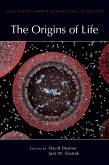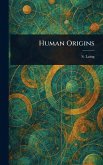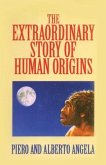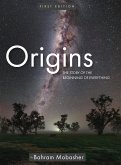Origins and Evolution of Life
An Astrobiological Perspective
Herausgeber: Gargaud, Muriel; Martin, Hervé; López-Garcìa, Purificación
Origins and Evolution of Life
An Astrobiological Perspective
Herausgeber: Gargaud, Muriel; Martin, Hervé; López-Garcìa, Purificación
- Gebundenes Buch
- Merkliste
- Auf die Merkliste
- Bewerten Bewerten
- Teilen
- Produkt teilen
- Produkterinnerung
- Produkterinnerung
Devoted to exploring questions about the origin and evolution of life in our Universe, this interdisciplinary book has widespread appeal.
Andere Kunden interessierten sich auch für
![Origins of Life in the Universe Origins of Life in the Universe]() Robert JastrowOrigins of Life in the Universe164,99 €
Robert JastrowOrigins of Life in the Universe164,99 €![Astrophysics of Life Astrophysics of Life]() Mario Livio / Neill Reid / William Sparks (eds.)Astrophysics of Life97,99 €
Mario Livio / Neill Reid / William Sparks (eds.)Astrophysics of Life97,99 €![Origins of Life, the CB Origins of Life, the CB]() Jack W SzostakOrigins of Life, the CB120,99 €
Jack W SzostakOrigins of Life, the CB120,99 €![Human Origins Human Origins]() S Laing (Samuel)Human Origins31,99 €
S Laing (Samuel)Human Origins31,99 €![Extraordinary Story of Human Origins Extraordinary Story of Human Origins]() Piero AngelaExtraordinary Story of Human Origins31,99 €
Piero AngelaExtraordinary Story of Human Origins31,99 €![Origins Origins]() Bahram MobasherOrigins121,99 €
Bahram MobasherOrigins121,99 €![Elwyn Simons: A Search for Origins Elwyn Simons: A Search for Origins]() John Fleagle (ed.)Elwyn Simons: A Search for Origins113,99 €
John Fleagle (ed.)Elwyn Simons: A Search for Origins113,99 €-
-
-
Devoted to exploring questions about the origin and evolution of life in our Universe, this interdisciplinary book has widespread appeal.
Produktdetails
- Produktdetails
- Verlag: Cambridge University Press
- Seitenzahl: 546
- Erscheinungstermin: 14. Februar 2011
- Englisch
- Abmessung: 259mm x 181mm x 30mm
- Gewicht: 1224g
- ISBN-13: 9780521761314
- ISBN-10: 052176131X
- Artikelnr.: 31192351
- Herstellerkennzeichnung
- Libri GmbH
- Europaallee 1
- 36244 Bad Hersfeld
- gpsr@libri.de
- Verlag: Cambridge University Press
- Seitenzahl: 546
- Erscheinungstermin: 14. Februar 2011
- Englisch
- Abmessung: 259mm x 181mm x 30mm
- Gewicht: 1224g
- ISBN-13: 9780521761314
- ISBN-10: 052176131X
- Artikelnr.: 31192351
- Herstellerkennzeichnung
- Libri GmbH
- Europaallee 1
- 36244 Bad Hersfeld
- gpsr@libri.de
Part I. What Is Life?: 1. Problems raised by a definition of life M.
Morange; 2. Some remarks about uses of cosmological anthropic 'principles'
D. Lambert; 3. Minimal cell: the biologist point of view C.
Brochier-Armanet; 4. Minimal cell: the computer scientist point of view H.
Bersini; 5. Origins of life: computing and simulation approaches B.
Billoud; Part II. Astronomical and Geophysical Context of the Emergence of
Life: 6. Organic molecules in interstellar medium C. Ceccarelli and C.
Cernicharo; 7. Cosmochemical evolution and the origin of life: insights
from meteorites S. Pizzarello; 8. Astronomical constraints on the emergence
of life M. Gounelle and T. Montmerle; 9. Formation of habitable planets J.
Chambers; 10. The concept of galactic habitable zone N. Prantzos; 11. The
young Sun and its influence on planetary atmospheres M. Güdel and J.
Kasting; 12. Climates of the Earth G. Ramstein; Part III. Role of Water in
the Emergence of Life: 13. Liquid water: a necessary condition to all forms
of life K. Bartik, G. Bruylants, E. Locci and J. Reisse; 14. The role of
water in the formation and evolution of planets T. Encrenaz; 15. Water on
Mars J. P. Bibring; Part IV. From Non-Living Systems to Life: 16. Energetic
constraints on prebiotic pathways: application to the emergence of
translation R. Pascal and L. Boiteau; 17. Comparative genomics and early
cell evolution A. Lazcano; 18. Origin and evolution of metabolisms J.
Peretó; Part V. Mechanisms for Life Evolution: 19. Molecular phylogeny:
inferring the patterns of evolution E. Douzery; 20. Horizontal gene
transfer: mechanisms and evolutionary consequences D. Moreira; 21. The role
of symbiosis in eukaryotic evolution A. Latorre, A. Durbán, A. Moya and J.
Peretó; Part VI. Life in Extreme Conditions: 22. Life in extreme
conditions: Deinococcus radiodurans, an organism able to survive prolonged
desiccation and high doses of ionising radiation S. Sommer and M. Toueille;
23. Molecular effects of UV and ionizing radiations on DNA J. Cadet and T.
Douki; 24. Molecular adaptations to life at high salt: lessons from
Haloarcula marismortui G. Zaccai; Part VII. Traces of Life and
Biosignatures: 25. Early life: nature, distribution and evolution F.
Westall; 26. Early eukaryotes in precambrian oceans E. Javaux; 27.
Biomineralisation mechanisms K. Benzerara and J. Miot; 28. Limits of life
and biosphere: lesson from detection of microorganisms in deep sea and deep
subsurface in the Earth K. Takai; Part VIII. Life Elsewhere?: 29. Titan and
the Cassini-Huygens mission J. Lunine and F. Raulin; 30. The role of
terrestrial analogue environments in astrobiology R. Léveillé; Index.
Morange; 2. Some remarks about uses of cosmological anthropic 'principles'
D. Lambert; 3. Minimal cell: the biologist point of view C.
Brochier-Armanet; 4. Minimal cell: the computer scientist point of view H.
Bersini; 5. Origins of life: computing and simulation approaches B.
Billoud; Part II. Astronomical and Geophysical Context of the Emergence of
Life: 6. Organic molecules in interstellar medium C. Ceccarelli and C.
Cernicharo; 7. Cosmochemical evolution and the origin of life: insights
from meteorites S. Pizzarello; 8. Astronomical constraints on the emergence
of life M. Gounelle and T. Montmerle; 9. Formation of habitable planets J.
Chambers; 10. The concept of galactic habitable zone N. Prantzos; 11. The
young Sun and its influence on planetary atmospheres M. Güdel and J.
Kasting; 12. Climates of the Earth G. Ramstein; Part III. Role of Water in
the Emergence of Life: 13. Liquid water: a necessary condition to all forms
of life K. Bartik, G. Bruylants, E. Locci and J. Reisse; 14. The role of
water in the formation and evolution of planets T. Encrenaz; 15. Water on
Mars J. P. Bibring; Part IV. From Non-Living Systems to Life: 16. Energetic
constraints on prebiotic pathways: application to the emergence of
translation R. Pascal and L. Boiteau; 17. Comparative genomics and early
cell evolution A. Lazcano; 18. Origin and evolution of metabolisms J.
Peretó; Part V. Mechanisms for Life Evolution: 19. Molecular phylogeny:
inferring the patterns of evolution E. Douzery; 20. Horizontal gene
transfer: mechanisms and evolutionary consequences D. Moreira; 21. The role
of symbiosis in eukaryotic evolution A. Latorre, A. Durbán, A. Moya and J.
Peretó; Part VI. Life in Extreme Conditions: 22. Life in extreme
conditions: Deinococcus radiodurans, an organism able to survive prolonged
desiccation and high doses of ionising radiation S. Sommer and M. Toueille;
23. Molecular effects of UV and ionizing radiations on DNA J. Cadet and T.
Douki; 24. Molecular adaptations to life at high salt: lessons from
Haloarcula marismortui G. Zaccai; Part VII. Traces of Life and
Biosignatures: 25. Early life: nature, distribution and evolution F.
Westall; 26. Early eukaryotes in precambrian oceans E. Javaux; 27.
Biomineralisation mechanisms K. Benzerara and J. Miot; 28. Limits of life
and biosphere: lesson from detection of microorganisms in deep sea and deep
subsurface in the Earth K. Takai; Part VIII. Life Elsewhere?: 29. Titan and
the Cassini-Huygens mission J. Lunine and F. Raulin; 30. The role of
terrestrial analogue environments in astrobiology R. Léveillé; Index.
Part I. What Is Life?: 1. Problems raised by a definition of life M.
Morange; 2. Some remarks about uses of cosmological anthropic 'principles'
D. Lambert; 3. Minimal cell: the biologist point of view C.
Brochier-Armanet; 4. Minimal cell: the computer scientist point of view H.
Bersini; 5. Origins of life: computing and simulation approaches B.
Billoud; Part II. Astronomical and Geophysical Context of the Emergence of
Life: 6. Organic molecules in interstellar medium C. Ceccarelli and C.
Cernicharo; 7. Cosmochemical evolution and the origin of life: insights
from meteorites S. Pizzarello; 8. Astronomical constraints on the emergence
of life M. Gounelle and T. Montmerle; 9. Formation of habitable planets J.
Chambers; 10. The concept of galactic habitable zone N. Prantzos; 11. The
young Sun and its influence on planetary atmospheres M. Güdel and J.
Kasting; 12. Climates of the Earth G. Ramstein; Part III. Role of Water in
the Emergence of Life: 13. Liquid water: a necessary condition to all forms
of life K. Bartik, G. Bruylants, E. Locci and J. Reisse; 14. The role of
water in the formation and evolution of planets T. Encrenaz; 15. Water on
Mars J. P. Bibring; Part IV. From Non-Living Systems to Life: 16. Energetic
constraints on prebiotic pathways: application to the emergence of
translation R. Pascal and L. Boiteau; 17. Comparative genomics and early
cell evolution A. Lazcano; 18. Origin and evolution of metabolisms J.
Peretó; Part V. Mechanisms for Life Evolution: 19. Molecular phylogeny:
inferring the patterns of evolution E. Douzery; 20. Horizontal gene
transfer: mechanisms and evolutionary consequences D. Moreira; 21. The role
of symbiosis in eukaryotic evolution A. Latorre, A. Durbán, A. Moya and J.
Peretó; Part VI. Life in Extreme Conditions: 22. Life in extreme
conditions: Deinococcus radiodurans, an organism able to survive prolonged
desiccation and high doses of ionising radiation S. Sommer and M. Toueille;
23. Molecular effects of UV and ionizing radiations on DNA J. Cadet and T.
Douki; 24. Molecular adaptations to life at high salt: lessons from
Haloarcula marismortui G. Zaccai; Part VII. Traces of Life and
Biosignatures: 25. Early life: nature, distribution and evolution F.
Westall; 26. Early eukaryotes in precambrian oceans E. Javaux; 27.
Biomineralisation mechanisms K. Benzerara and J. Miot; 28. Limits of life
and biosphere: lesson from detection of microorganisms in deep sea and deep
subsurface in the Earth K. Takai; Part VIII. Life Elsewhere?: 29. Titan and
the Cassini-Huygens mission J. Lunine and F. Raulin; 30. The role of
terrestrial analogue environments in astrobiology R. Léveillé; Index.
Morange; 2. Some remarks about uses of cosmological anthropic 'principles'
D. Lambert; 3. Minimal cell: the biologist point of view C.
Brochier-Armanet; 4. Minimal cell: the computer scientist point of view H.
Bersini; 5. Origins of life: computing and simulation approaches B.
Billoud; Part II. Astronomical and Geophysical Context of the Emergence of
Life: 6. Organic molecules in interstellar medium C. Ceccarelli and C.
Cernicharo; 7. Cosmochemical evolution and the origin of life: insights
from meteorites S. Pizzarello; 8. Astronomical constraints on the emergence
of life M. Gounelle and T. Montmerle; 9. Formation of habitable planets J.
Chambers; 10. The concept of galactic habitable zone N. Prantzos; 11. The
young Sun and its influence on planetary atmospheres M. Güdel and J.
Kasting; 12. Climates of the Earth G. Ramstein; Part III. Role of Water in
the Emergence of Life: 13. Liquid water: a necessary condition to all forms
of life K. Bartik, G. Bruylants, E. Locci and J. Reisse; 14. The role of
water in the formation and evolution of planets T. Encrenaz; 15. Water on
Mars J. P. Bibring; Part IV. From Non-Living Systems to Life: 16. Energetic
constraints on prebiotic pathways: application to the emergence of
translation R. Pascal and L. Boiteau; 17. Comparative genomics and early
cell evolution A. Lazcano; 18. Origin and evolution of metabolisms J.
Peretó; Part V. Mechanisms for Life Evolution: 19. Molecular phylogeny:
inferring the patterns of evolution E. Douzery; 20. Horizontal gene
transfer: mechanisms and evolutionary consequences D. Moreira; 21. The role
of symbiosis in eukaryotic evolution A. Latorre, A. Durbán, A. Moya and J.
Peretó; Part VI. Life in Extreme Conditions: 22. Life in extreme
conditions: Deinococcus radiodurans, an organism able to survive prolonged
desiccation and high doses of ionising radiation S. Sommer and M. Toueille;
23. Molecular effects of UV and ionizing radiations on DNA J. Cadet and T.
Douki; 24. Molecular adaptations to life at high salt: lessons from
Haloarcula marismortui G. Zaccai; Part VII. Traces of Life and
Biosignatures: 25. Early life: nature, distribution and evolution F.
Westall; 26. Early eukaryotes in precambrian oceans E. Javaux; 27.
Biomineralisation mechanisms K. Benzerara and J. Miot; 28. Limits of life
and biosphere: lesson from detection of microorganisms in deep sea and deep
subsurface in the Earth K. Takai; Part VIII. Life Elsewhere?: 29. Titan and
the Cassini-Huygens mission J. Lunine and F. Raulin; 30. The role of
terrestrial analogue environments in astrobiology R. Léveillé; Index.








